ISSN ONLINE(2319-8753)PRINT(2347-6710)
ISSN ONLINE(2319-8753)PRINT(2347-6710)
| Prof.V.M.Prajapati, Prof.K.H.Thakkar, Prof.S.A.Thakkar, Prof.H.B.Parikh 1Assistant Professor, Department of Mechanical Engineering, S.P.C.E.Visnagar, Gujarat, India |
| Related article at Pubmed, Scholar Google |
Visit for more related articles at International Journal of Innovative Research in Science, Engineering and Technology
CNC milling is one of the most commonly used in industry and machine shops today for machining parts to precise sizes and shapes. The objective of this experimental investigation is to conduct research of machining parameters of the machine impact on product quality and productivity of the process. For the analysis input parameters like feed rate, spindle speed and depth of cut selected as a control factors in Taguchi technique of response variable optimization with keeping operating chamber temperature and the usage of different tool inserts constant. And the product quality in terms of Surface roughness and productivity as material removal rate is measured. An orthogonal array of L3 was used and ANAOVA were performed to find out the significance of each of the input parameters on the Surface roughness and material removal rate.
Keywords |
| Taguchi design; Surface roughness; Milling operations |
INTRODUCTION |
1.1. Background |
| As a basic machining process, milling is one of the most widely used metal removal processes in industry and milled surfaces are largely used to mate with other parts in die, aerospace, automotive, and machinery design as well as in manufacturing industries [1,2]. Surface roughness is an important measure of the technological quality of a product and a factor that greatly influences manufacturing cost. The mechanism behind the formation of surface roughness is very dynamic, complicated, and process dependent; it is very difficult to calculate its value through theoretical analysis [3]. Therefore, machine operators usually use “trial and error” approaches to set-up milling machine cutting conditions in order to achieve the desired surface Roughness. Obviously, the “trial and error” method is not is a repetitive and empirical process that can be very time consuming. The dynamic nature and widespread usage of milling operations in practice have raised a need for seeking a systematic Approach that can help to set-up milling operations in a timely manner and also to help achieve the desired surface roughness quality. |
1.2. Background of Taguchi design |
| One method presented in this study is an experimental design process called the Taguchi design method. Taguchi design, developed by Dr. Genichi Taguchi, is a set of methodologies by which the inherent variability of materials and manufacturing processes has been taken into account at the design stage. The application of this technique had become widespread in many US and European industries after the 1980s. The beauty of Taguchi design is that multiple factors can be considered at once. Moreover, it seeks nominal design points that are insensitive to variations in production and user environments to improve the yield in manufacturing and the reliability in performance of a product [4]. Therefore, not only can controlled factors be considered, but also noise factors. Although similar to design of experiment (DOE), the Taguchi design only conducts |
1.3. Procedure of the Taguchi design method |
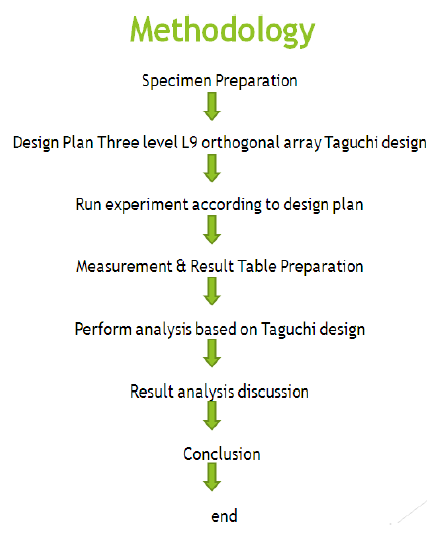 |
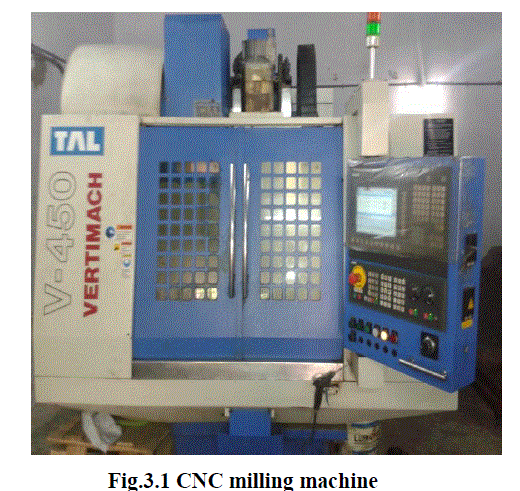 |
II. SURFACE FINISHING IN MACHINING |
| a. Ideal roughness, and b. Natural roughness. 2.1 Measurement of surface roughness 1. Direct measurement methods2. Comparison based techniques3. Non contact methods4. On-process measurement 2.2factors Influencing Surface Roughness In Milling (i) Depth of cut:(ii) Feed:(iii) Cutting speed: (iv)Engagement of the cutting tool: |
III. EXPERIMENTAL SET UP |
| 3.1 Machine Specification --CNC system: Siemens 802DSL Pro. |
| --Voltage:415 V A.C. --Spindle Speed:-8000 r.p.m --Feed rate:-10000 mm/min --Machine Loading Capacity:400 kg --Working table:680*440*500 --Tool Specification: Carbide end mill --Surface Measurement instrument: Mitutoyo SJ 210 |
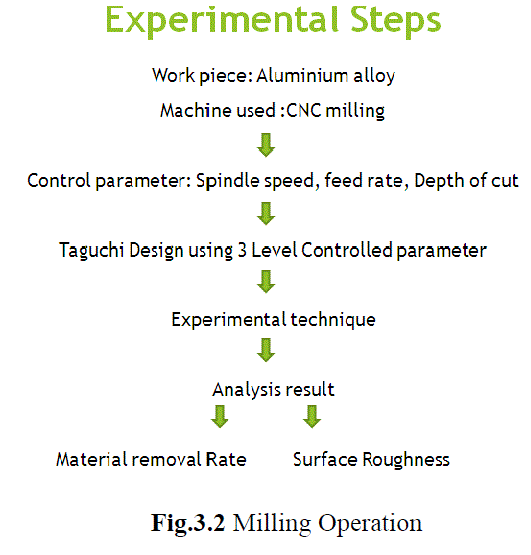 |
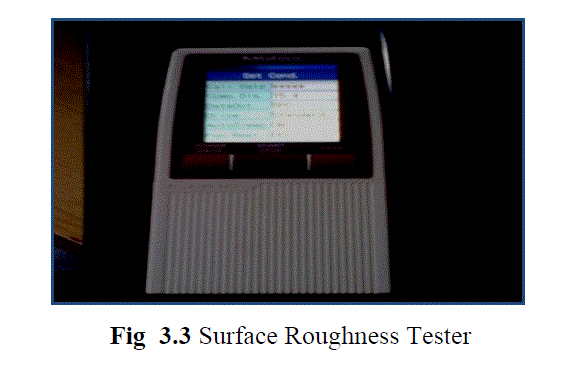 |
 |
| The Taguchi method aims to find an optimal combination of parameters that have the smallest variance in performance. The signal-to-noise (S/N) ratio measures how the response varies relative to the nominal or target value under different noise conditions. Minitab 15 software help to calculate S/N Ratio based on required response and provide Analysis of variance table and response plot for deciding significant parameter and to find (%) percentage contribution of each parameter. Mean SN ratio plot gives idea about the optimum level for the factor. It is preferred to do S/N analysis as mean sum of square may be too small in case of mean analysis. It is very accurate to judge the optimum parameter based on SN Ratio analysis. Minitab offer both mean analysis as well as S/N Ratio base ANOVA. Minitab 15 helps to make orthogonal array. The snap shot of software application shown in figure while doing analysis work |
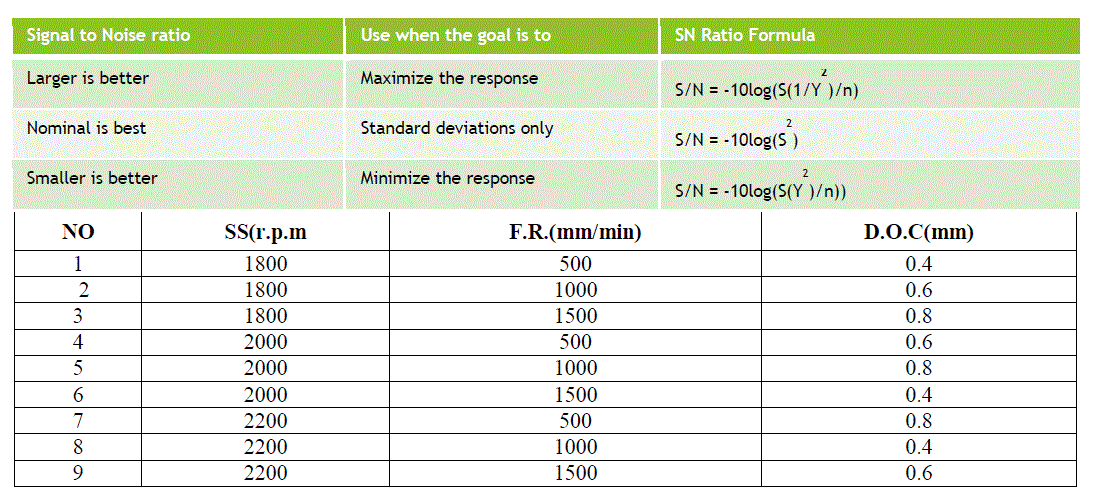 |
 |
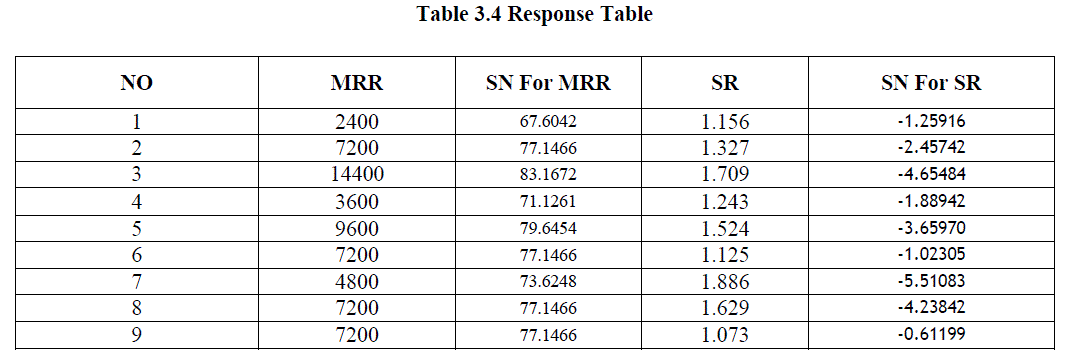 |
 |
 |
IV. RESULT AND DISCUSSION |
| -Analysis of Variance tables shows the effect of parameter on MRR. The significant --parameters can be easily identified and rank the parameter as per the response table. -Feed rate is a most significance factor for MRR. Spindle Speed and Depth of cut are insignificant control parameter. -Rank order as per the significance level is Spindle speed, Feed rate and Depth of cut. -Percentage contribution of residual error is 4.869%. It strengthens the analysis as it is -on minimum side. Maximum % percentage contribution of Feed rate is 72.540%. |
4.1Main effect plot of MRR |
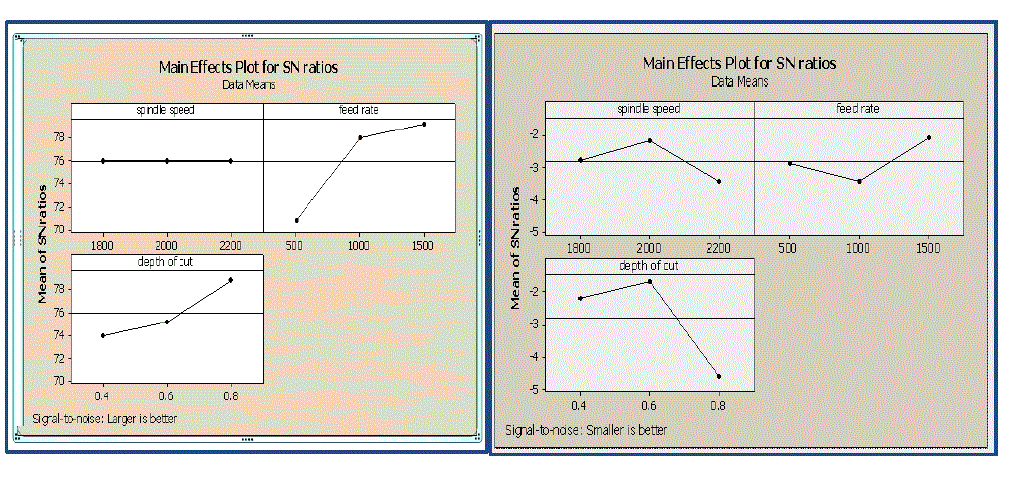 |
V.CONCLUSIONS |
| In this study the optimal cutting condition for face milling was selected by varying cutting parameters through the Taguchi parameter design method. With the L3(9) orthogonal array, a total of 9experimental runs, covering three main factors each at three levels and two noise factors each at two levels, indicated that the Taguchi parameter design was an efficient way of Determining the optimal cutting parameters for surface finish. Feed rate (FR) is the most significant factor on MRR. The recommended parametric combination for optimum material removal rate is SS (1800/2000/2200) FR (1500) DOC (0.8). In case of surface Roughness, Spindle speed is most significant control factor and hence the optimum recommended parametric combination for optimum surface Roughness is SS (2000) FR (1500) DOC (0.6). This was accomplished with a relatively small number of experimental runs, given the number of control and noise factors, suggesting that Taguchi parameter design is an efficient and effective method for optimizing surface roughness in a milling operation. |
References |
|